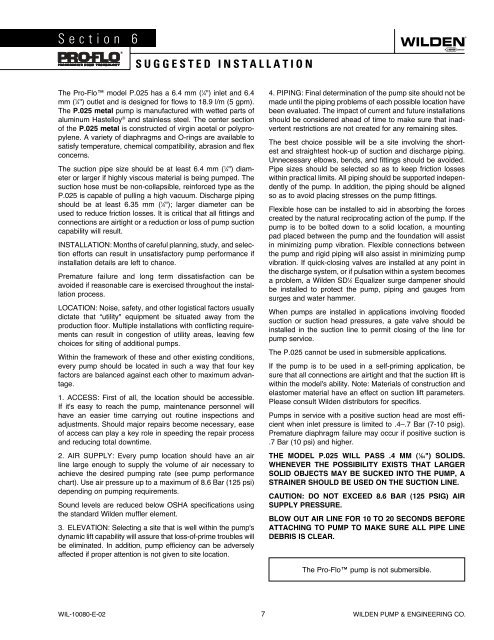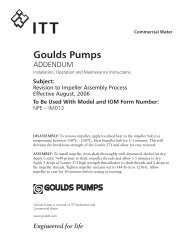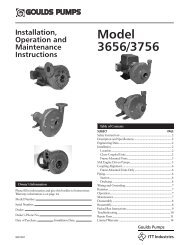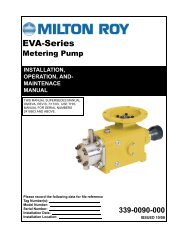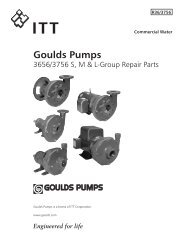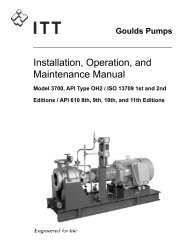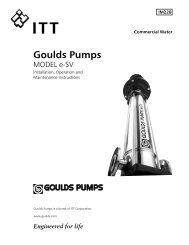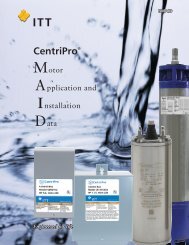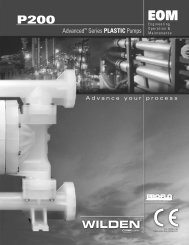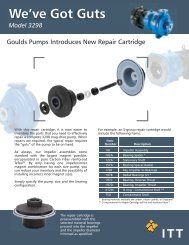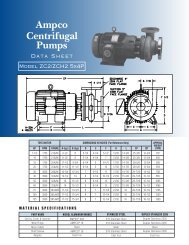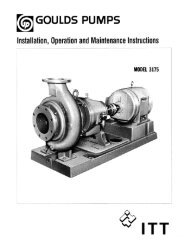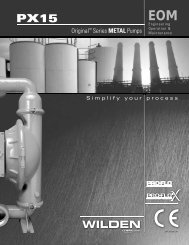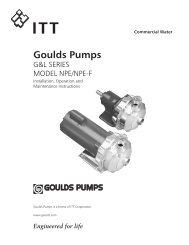¼" Pro-Flo metal pump (P0.25) - Process Pumps
¼" Pro-Flo metal pump (P0.25) - Process Pumps
¼" Pro-Flo metal pump (P0.25) - Process Pumps
- No tags were found...
Create successful ePaper yourself
Turn your PDF publications into a flip-book with our unique Google optimized e-Paper software.
Section 6SUGGESTED INSTALLATIONThe <strong>Pro</strong>-<strong>Flo</strong> model P.025 has a 6.4 mm ( 1 ⁄4") inlet and 6.4mm ( 1 ⁄4") outlet and is designed for flows to 18.9 l/m (5 gpm).The P.025 <strong>metal</strong> <strong>pump</strong> is manufactured with wetted parts ofaluminum Hastelloy ® and stainless steel. The center sectionof the P.025 <strong>metal</strong> is constructed of virgin acetal or polypropylene.A variety of diaphragms and O-rings are available tosatisfy temperature, chemical compatibility, abrasion and flexconcerns.The suction pipe size should be at least 6.4 mm ( 1 ⁄4") diameteror larger if highly viscous material is being <strong>pump</strong>ed. Thesuction hose must be non-collapsible, reinforced type as theP.025 is capable of pulling a high vacuum. Discharge pipingshould be at least 6.35 mm ( 1 ⁄4"); larger diameter can beused to reduce friction losses. It is critical that all fittings andconnections are airtight or a reduction or loss of <strong>pump</strong> suctioncapability will result.INSTALLATION: Months of careful planning, study, and selectionefforts can result in unsatisfactory <strong>pump</strong> performance ifinstallation details are left to chance.Premature failure and long term dissatisfaction can beavoided if reasonable care is exercised throughout the installationprocess.LOCATION: Noise, safety, and other logistical factors usuallydictate that “utility" equipment be situated away from theproduction floor. Multiple installations with conflicting requirementscan result in congestion of utility areas, leaving fewchoices for siting of additional <strong>pump</strong>s.Within the framework of these and other existing conditions,every <strong>pump</strong> should be located in such a way that four keyfactors are balanced against each other to maximum advantage.1. ACCESS: First of all, the location should be accessible.If it's easy to reach the <strong>pump</strong>, maintenance personnel willhave an easier time carrying out routine inspections andadjustments. Should major repairs become necessary, easeof access can play a key role in speeding the repair processand reducing total downtime.2. AIR SUPPLY: Every <strong>pump</strong> location should have an airline large enough to supply the volume of air necessary toachieve the desired <strong>pump</strong>ing rate (see <strong>pump</strong> performancechart). Use air pressure up to a maximum of 8.6 Bar (125 psi)depending on <strong>pump</strong>ing requirements.Sound levels are reduced below OSHA specifications usingthe standard Wilden muffler element.3. ELEVATION: Selecting a site that is well within the <strong>pump</strong>'sdynamic lift capability will assure that loss-of-prime troubles willbe eliminated. In addition, <strong>pump</strong> efficiency can be adverselyaffected if proper attention is not given to site location.4. PIPING: Final determination of the <strong>pump</strong> site should not bemade until the piping problems of each possible location havebeen evaluated. The impact of current and future installationsshould be considered ahead of time to make sure that inadvertentrestrictions are not created for any remaining sites.The best choice possible will be a site involving the shortestand straightest hook-up of suction and discharge piping.Unnecessary elbows, bends, and fittings should be avoided.Pipe sizes should be selected so as to keep friction losseswithin practical limits. All piping should be supported independentlyof the <strong>pump</strong>. In addition, the piping should be alignedso as to avoid placing stresses on the <strong>pump</strong> fittings.Flexible hose can be installed to aid in absorbing the forcescreated by the natural reciprocating action of the <strong>pump</strong>. If the<strong>pump</strong> is to be bolted down to a solid location, a mountingpad placed between the <strong>pump</strong> and the foundation will assistin minimizing <strong>pump</strong> vibration. Flexible connections betweenthe <strong>pump</strong> and rigid piping will also assist in minimizing <strong>pump</strong>vibration. If quick-closing valves are installed at any point inthe discharge system, or if pulsation within a system becomesa problem, a Wilden SD 1 ⁄2 Equalizer surge dampener shouldbe installed to protect the <strong>pump</strong>, piping and gauges fromsurges and water hammer.When <strong>pump</strong>s are installed in applications involving floodedsuction or suction head pressures, a gate valve should beinstalled in the suction line to permit closing of the line for<strong>pump</strong> service.The P.025 cannot be used in submersible applications.If the <strong>pump</strong> is to be used in a self-priming application, besure that all connections are airtight and that the suction lift iswithin the model's ability. Note: Materials of construction andelastomer material have an effect on suction lift parameters.Please consult Wilden distributors for specifics.<strong>Pumps</strong> in service with a positive suction head are most efficientwhen inlet pressure is limited to .4–.7 Bar (7-10 psig).Premature diaphragm failure may occur if positive suction is.7 Bar (10 psi) and higher.THE MODEL P.025 WILL PASS .4 MM ( 1 ⁄64") SOLIDS.WHENEVER THE POSSIBILITY EXISTS THAT LARGERSOLID OBJECTS MAY BE SUCKED INTO THE PUMP, ASTRAINER SHOULD BE USED ON THE SUCTION LINE.CAUTION: DO NOT EXCEED 8.6 BAR (125 PSIG) AIRSUPPLY PRESSURE.BLOW OUT AIR LINE FOR 10 TO 20 SECONDS BEFOREATTACHING TO PUMP TO MAKE SURE ALL PIPE LINEDEBRIS IS CLEAR.The <strong>Pro</strong>-<strong>Flo</strong> <strong>pump</strong> is not submersible.WIL-10080-E-02 7 WILDEN PUMP & ENGINEERING CO.


